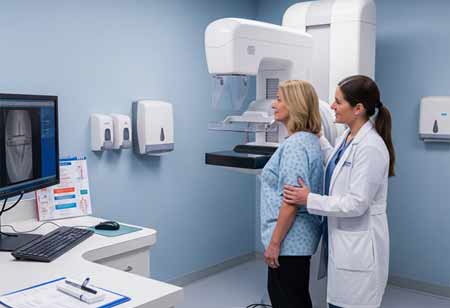Thank you for Subscribing to Healthcare Business Review Weekly Brief
Be first to read the latest tech news, Industry Leader's Insights, and CIO interviews of medium and large enterprises exclusively from Healthcare Business Review
Canada Advances Breast Cancer Screening with Digital Innovation
Breast cancer screening services in Canada enhance early detection through digital innovation, equitable access, and personalized care, supporting better outcomes and informed healthcare decisions nationwide.

By
Healthcare Business Review | Friday, August 29, 2025
Stay ahead of the industry with exclusive feature stories on the top companies, expert insights and the latest news delivered straight to your inbox. Subscribe today.
Breast cancer screening services in Canada represent a cornerstone of the national healthcare strategy aimed at early detection and improved outcomes. By identifying abnormalities at an earlier, more treatable stage, these services reduce the mortality and long-term impact associated with breast cancer. The screening infrastructure, supported by public health initiatives and advanced imaging technologies, offers comprehensive access to eligible individuals across provinces and territories. With continuous innovation and policy evolution, breast cancer screening programs remain critical in enhancing public health outcomes and enabling informed clinical decisions nationwide.
Evolving Landscape of Breast Cancer Screening in Canada
Canada's breast cancer screening landscape is characterized by a structured and province-driven approach emphasizing population-based participation. Organized screening programs across regions have adopted standardized protocols, typically inviting individuals within defined age groups for regular mammographic assessments. Increased awareness campaigns, supported by government and non-profit collaborations, have driven higher screening uptake rates in urban and semi-urban populations.
Integrating digital mammography and centralized data management systems has improved diagnostic accuracy and enabled better tracking of individual screening histories. This evolution reflects a shift from opportunistic screening to systematic engagement, focusing on reaching eligible individuals consistently. Efforts are being made to refine risk-based screening models, incorporating personal and family medical history, providing a more tailored approach to screening frequency and methodology. The widespread use of mobile screening units has also improved accessibility for remote and underserved communities, fostering greater equity across the healthcare system.
Navigating Barriers Through Integrated Solutions
One persistent challenge in the Canadian breast cancer screening system is ensuring equitable access across diverse geographic regions. Rural, remote, and Indigenous communities often face logistical barriers due to limited transportation infrastructure or healthcare facilities. To address this, provinces have implemented mobile mammography units and telehealth consultations, bringing services directly to underserved areas. These mobile services are equipped with modern digital imaging and are coordinated with regional health centers to ensure follow-up care and diagnostic support.
Another challenge is the variability of screening guidelines across provinces, which leads to inconsistent practices and confusion among eligible individuals and healthcare providers. National consensus-building efforts and alignment of recommendations through evidence-based research have mitigated this. Cross-provincial dialogue and collaboration aim to harmonize screening intervals and eligibility criteria, ensuring a more uniform patient experience regardless of location.
Another barrier involves cultural and language-related obstacles that may hinder participation among immigrant populations and non-English-speaking communities. Educational materials, outreach programs, and navigator services have been adapted to reflect linguistic and cultural diversity. These resources assist individuals in understanding the importance of screening, what to expect during the process, and how to navigate the system.
Concerns about discomfort, fear of diagnosis, or misconceptions about radiation exposure also contribute to low participation among some segments of the population. Healthcare providers and public health organizations have addressed this by investing in patient-centered care approaches, enhancing communication strategies, and offering counseling to alleviate anxiety. Educational campaigns now emphasize the safety, speed, and preventive value of mammographic screening, encouraging more informed participation.
Advancements and Strategic Growth Benefiting the Healthcare Ecosystem
Technological innovation has significantly impacted breast cancer screening services across Canada. The shift from film to digital mammography has improved image quality, streamlined data storage, and enabled faster interpretations. More recently, the adoption of tomosynthesis, or 3D mammography, has enhanced diagnostic accuracy by reducing false positives and better detecting abnormalities in dense breast tissue. This advancement reduces the need for repeat imaging and increases clinicians' confidence in early-stage detection.
Artificial intelligence is evolving into an integral tool in supporting radiologists during the interpretation of mammograms. AI algorithms assist in identifying patterns that may be difficult to detect manually, improving the speed and accuracy of assessments. These tools are also being explored to stratify risk more effectively and recommend personalized screening pathways based on individual profiles.
Opportunities for improvement also exist in expanding personalized screening strategies. With growing evidence supporting risk-based models, programs are beginning to adopt approaches that consider genetic predispositions, hormone use, and breast density. These refined methods enable more precise recommendations for screening intervals and modalities, enhancing outcomes while optimizing resource use.
Digital platforms contribute to improved patient engagement by enabling appointment scheduling, result notifications, and educational outreach through user-friendly online portals. This digital integration enhances transparency, simplifies administrative tasks, and supports ongoing patient-provider communication. Stakeholders, including healthcare professionals, policymakers, and community leaders, benefit from data-driven insights that support strategic planning, program evaluation, and targeted outreach.
There is also potential for collaboration between provinces and research institutions to develop national databases that track long-term screening outcomes. Such data aggregation could offer insights into population health trends, program performance, and innovation effectiveness. These collaborative efforts promise to enhance public health planning and foster a more resilient screening infrastructure.






